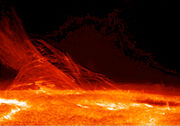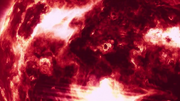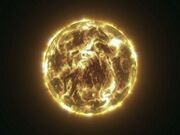| Sun > HD 149026b > Nemesis |
- "The sun a medium sized star, remain stable for approximately 10,000,000,000 years."
- — William Shatner, Universe
| Sun | |
|---|---|
| 1st appearance: | Creation |
| Status: | Alive |
| Age: | ~ 6,000 years |
| Planets: | 10 |
| Temperature: | 9,941°F |
| Rotation: | 23 hrs 56 mins 4 secs |
| Type: | Medium star |
| Diameter: | 900,000 mi |
| Gender: | Female |
| Voice actor(s): | Janis Cody |
| Death: | Boiled alive (revived), exploded (revived again), died in explosion (revived), boiled alive in animated show (revived) |

Name[]
- Sun
- Also know as The Sun or Sol
The Sun (in Greek: Helios, in Latin: SolTemplate:Efn) is the star at the center of the Solar System and is by far the most important source of energy for life on Earth. It is a nearly perfect spherical ball of hot plasma, The Sun is a G-type main-sequence star (G2V) based on spectral class and it is informally referred to as a yellow dwarf. It formed approximately 4.567 billion[lower-alpha 1][1] years ago from the gravitational collapse of matter within a region of a large molecular cloud. Most of this matter gathered in the center, whereas the rest flattened into an orbiting disk that became the Solar System. The central mass became increasingly hot and dense, eventually initiating nuclear fusion in its core. It is thought that almost all stars form by this process.
The Red giant Sun's death[]
The Sun eventually uses up its Hydrogen (H2) gas and it expands to 400 times its present diameter in another ten billion years it will glow red hot, and it would get Theia baked in a heat that is 3,600°F, after it has already engulfed Mars, Earth, Venus, and Mercury. The Sun completely fill the horizon on the fourth and a half planet of the Solar System, the seas would evaporate into gas, but Theia looks nothing like it use to. No signs indicate it would have ever sustained life. And then the final lack, The Sun's massive outer edges of its photosphere would begin to slow down Theia's orbit, the Martian planet would be a fireball, and starting to be burning up like a meteorite also it's going to be engulfed by our own star the red giant Sun and it's going to be toast, vapor literally. And our red giant would fall leaving behind a corpse of star called a white dwarf, over fifteen billion years the Sun would end its life as a black dwarf star. About 74% of the Sun's mass is hydrogen, 25% is helium, and the rest is made up of trace quantities of heavier elements. Each second, more than 4 million tons of matter are converted into energy within the Sun's core, producing neutrinos and solar radiation. In about 5 billion years, in is predicted that the Sun will evolve into a red giant and then a white dwarf, creating a planetary nebula in the process. The Sun is a magnetically active star; it supports a strong, changing magnetic field that varies year-to-year and reverses direction about every eleven years. The Sun's magnetic field gives rise to many effects that are collectively called solar activity, including sunspots on the surface of the Sun, solar flares, and variations in the solar wind that carry material through the solar system. The effects of solar activity on Earth include auroras at moderate to high latitudes, and the disruption of radio communications and electric power. Solar activity is thought to have played a large role in the formation and evolution of the solar system, and strongly affects the structure of Earth's outer atmosphere.
Although it is the nearest star to Earth and has been intensively studied by scientists, many questions about the Sun remain unanswered, such as why its outer atmosphere has a temperature of over a million Kelvin while its visible surface (the photosphere) has a temperature of just 6,000 K. Current topics of scientific inquiry include the sun's regular cycle of sunspot activity, the physics and origin of solar flares and prominences, the magnetic interaction between the chromosome and the corona, and the origin of the solar wind.
Discovery date[]
- Has always been known to man.[2]
Discoverer[]
- Always been known by mankind.[2]
Orbiters in order from star[]
Dwarf planets[]
Dwarf planet candidates[]
Minor planets[]
Characteristics[]
- Mass = 1.989 x 1030 kg[2], this mass is known as one (1) solar mass.[3]
- Radius = 6.955×105 km, this radius is known as one (1) solar radius.[3]
- Effective temperature = 5777 K, 5504 °C or 9939 °F[2]
- Age = 4.6 billion years[2]
About the star[]
- G-type star.[2]
- Our own Sun is in fact white, but appears yellow through the Earth's atmosphere. [3]
- About one million Earths could fit inside the Sun.[4]
- At the core, the temperature is about 15 million °C (about 27 million °F), which is sufficient to sustain thermonuclear fusion.[4]
- The Sun is at its mid-life, and should keep its appearance for an other five (5) billion years.
- The density of the Sun is 1.4 g/cm3<\sup>[5]
Parts of the Sun[]
- Core[3]
- Radioactive Zone[3]
- Convective Zone[3]
- Photoshpere[3]
- Chromosphere[3]
- Corona[3]
- Sunspots[3]
- Granules[3]
- Prominence[3]
The Sun's Life Cycle[6][]
Voice Actors[]
- Janis Cody (UK/US; eighteenth - twentienth season)
- Amy Satras (UK/US; seventeenth - eighteenth season)
- Diana Radomski (UK/US; sixteenth - seventeenth season)
- Vanessa Porco (UK/US; fifteenth - sixteenth season)
- Fu Suzuki (Japan; fifteenth season onwards)
Gallery[]
Sources[]
References[]
- ↑ 1.0 1.1 Connelly, James N.; Bizzarro, Martin; Krot, Alexander N.; Nordlund, Åke; Wielandt, Daniel; Ivanova, Marina A. (2 November 2012). "The Absolute Chronology and Thermal Processing of Solids in the Solar Protoplanetary Disk". Science 338 (6107): 651–655. doi:10.1126/science.1226919. PMID 23118187. Bibcode: 2012Sci...338..651C.
- ↑ 2.0 2.1 2.2 2.3 2.4 2.5 http://solarsystem.nasa.gov/planets/profile.cfm?Object=Sun&Display=Facts&System=Metric
- ↑ 3.00 3.01 3.02 3.03 3.04 3.05 3.06 3.07 3.08 3.09 3.10 3.11 http://en.wikipedia.org/wiki/Sun
- ↑ 4.0 4.1 http://solarsystem.nasa.gov/planets/profile.cfm?Object=Sun&Display=OverviewLong
- ↑ http://www.universetoday.com
- ↑ http://en.wikipedia.org/wiki/File:Solar_Life_Cycle.svg
[[Category:Celestial Bodies known
 |
Cite error: <ref> tags exist for a group named "lower-alpha", but no corresponding <references group="lower-alpha"/> tag was found
















